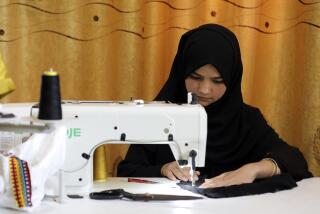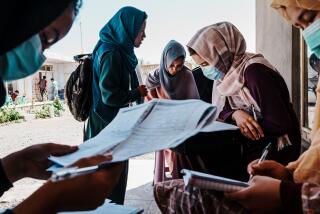Remnants of Afghan Wars Offer Potential
- Share via
SHOMALI PLAIN, Afghanistan — Driving through this once-verdant farm area ruined by decades of warfare, Shreeram Lakshman’s eyes rest on the wreckage of a T-54 Soviet tank, one of dozens that litter the countryside.
“That’s nice stuff. That will melt down really well,” the Indian businessman said of the rusting hulk resting along a collapsed bridge in a dried-up irrigation canal. Beyond it lie dozens of ruined and abandoned mud-brick houses.
Lakshman wants to beat swords into plowshares--melt down the thousands of abandoned tanks, armored vehicles and artillery pieces that blanket Afghanistan to make the steel rods, beams and sheets that could be the building blocks for this devastated nation’s reconstruction.
The abandoned armor testifies to the billions of dollars the Soviets poured into their occupation of Afghanistan during the 1980s. But to Lakshman, the wrecks are the stuff of Afghanistan’s recovery.
Despite bureaucratic disarray and a near total lack of infrastructure, not to mention this country’s highly unsettled future, hundreds of entrepreneurs such as Lakshman are looking for opportunities in Afghanistan.
But the obstacles of doing business in a land with no formal banking system, no reliable telephone system, an inchoate legal structure and fledgling government are immense. The assassination attempt on President Hamid Karzai and fatal bombings in downtown Kabul last week also underscore the precariousness of Afghanistan’s future.
All this presents plenty of opportunities for Lakshman’s venture to fail, and odds are it will. He admits that the project is a longshot.
“There is no road map here,” Lakshman said.
*
Finding Opportunities
But that isn’t stopping entrepreneurs from exploring business opportunities in Afghanistan for the short and long term. The government talks of untapped deposits of minerals such as coal and copper and is trying to interest foreign companies in developing its oil and gas fields.
Lakshman heads the Afghan office of the Trade Group Confederation of Indian Industry. His job is to look for opportunities for its members, many of whom seem undeterred from investing in Afghanistan despite its problems. Like entrepreneurs the world over, they want to be in on the ground floor of what could be the next lucrative business opportunity.
One interested Indian businessman is Ashok Goyal, who is mulling over a $1-million investment in a smelter--which would be Afghanistan’s first--to be built in an industrial park in Kabul, the capital.
The operation he envisions would use only about 35% of the metal in a typical heavy tank; the rest is too thick for the proposed smelter and would have to be sold to steel mills in Russia or Ukraine.
Goyal is not the first to see a profit in Afghan war junk. During the chaos of the early 1990s, after the Soviets withdrew and Afghanistan was racked by civil war, most of the country’s easily transportable iron waste was taken to Pakistan and Iran and sold as scrap. What is left is heavier and more difficult to dispose of.
*
Demand for Steel
Goyal said his project would employ 200 people and sell into a market crying out for domestically produced steel.
“All of Afghanistan’s steel is brought in from other places, and it’s very expensive to transport it,” Goyal said, adding that the poor road system increases the costs of delivery.
Afghanistan also was systematically plundered of factory machines, high-tension wires, metal light poles and roofing--anything that could be picked up and rolled away.
The looting of industrial machinery and infrastructure, on top of myriad other calamities suffered over the years, has left Afghanistan’s economy in desperate shape.
“It’s as bad as Dresden in 1945,” said one U.S. official who asked not to be identified. Total annual economic output is about $5 billion, one-third that of impoverished Ecuador, although it has nearly 2 1/2 times the land mass and twice the population of Ecuador.
The United States, the European Union and the World Bank soon will unveil a massive road-building plan to boost the government of President Hamid Karzai and make transporting goods more efficient. Completion of any major road projects, however, is at least two years away.
“Although industrial policy is not fully realized in Afghanistan, there is a lot of potential,” Goyal said.
The country has never had a steel industry, but Lakshman and Goyal want to change that. The demand for recycled steel is high. The country’s reconstruction will need reinforcing steel rods and beams for rebuilding ruined housing, schools, hospitals and office buildings.
*
Thousands of Tanks
There is enough material to supply the Indians’ planned smelter for several years. The Defense Ministry estimates that 8,000 Soviet tanks and armored personnel carriers are rusting along the roadways, valleys and mountain passes, successively used and then abandoned by the Soviets, Afghan civil warriors and Taliban army over the last two decades.
And when the tanks run out, there would still be plenty of abandoned cars, planes and cargo containers to keep the smelter in business.
The smelter would buy the wrecks from the Defense Ministry, which claims ownership but has established no clear policy about how to dispose of them. “It’s not something we have put any focus on yet,” ministry spokesman Meer Jan said.
Although some villages are using tanks stacked ingeniously to prop up damaged bridges or to channel river water, many Afghans would be glad to see the hulks cleared from the highways.
“People shouldn’t have to see them anymore, because during the war many people’s close friends and loved ones were martyred, and the wrecks only remind them of that,” said Padshah, 30, a Kabul resident whose mother and eight siblings were ordered off their small Shomali Valley farm by the Taliban five years ago. “They should be collected and made into something useful.”
That’s what Lakshman and Goyal would like to do. On his tour of this valley where war wreckage has replaced pastures and vineyards, Lakshman saw steel waiting to be harvested and recycled--large amounts of it, there for the taking.
“To just let it rust there is really sad,” Lakshman said after turning east into the armor-strewn Panjshir Valley, where the Soviets lost hundreds of tanks in a single 1982 battle.
Whereas the Soviet junk armor lures Lakshman, it’s a source of puzzlement to others, who don’t know why the Soviets left so much behind when they withdrew from Afghanistan in 1989.
“It is odd. In East Germany and parts of the Baltic states, when the Russians withdrew, they were known to take everything--I mean everything, including the toilets; and what they didn’t take, they destroyed,” said Sarah Mendelson, a Russia scholar at the Center for Strategic and International Studies in Washington.
“This was a military ... in disintegration. Is it possible that no one gave any explicit orders?” she said.
Regardless of why it’s there, the abandoned war machinery is drawing other foreign entrepreneurs who have the same idea as Lakshman and Goyal.
Chinese executives from Shanghai have formed the Sino-Afghan Steel Co. to build a smelter in Kabul, and Afghan American steel executive Temoor Sidiqi, who emigrated in 1970 with his family, is trying to form a consortium to build a $200-million project that would start operations as a smelter but evolve into a full-fledged steel mill using iron ore from untapped mines in Bamiyan province.
Sidiqi talks of vast untapped--and unproven--deposits not just of iron but of copper, gold, fertilizer and coal.
“Just like other countries in the Mideast are big energy suppliers, I see Afghanistan developing as the region’s main minerals supplier,” said Sidiqi, whose Pittsburgh-based company, Forsarca Inc., sells management software to steel mills.
But this nation’s mineral reserves haven’t been accurately surveyed for a quarter of a century. With the country’s database and geological laboratory and its instruments in ruins, the nation has turned to the U.S. Geological Survey for help in sizing up its potential minerals as well as gas and petroleum reserves.
*
Boosting Interest
The government is trying to get oil companies interested in developing oil and gas fields in the northern part of the country and building a pipeline to Kabul.
Like mining projects, pipelines would cost a fortune to complete and investors are likely to wait until the political situation settles down before making such a big move.
Afghan officials say Washington already has agreed to help with the mineral survey, but U.S. officials say they still are considering it.
“We can build the economy of the country with natural resources, I have no doubt about it,” said Mohammad Sadiq, the Afghan Mining and Industry Ministry’s acting head of planning and chief of the geological survey. “We have almost every element on the periodic table.”
But a full-fledged mining project may take years to get off the ground. The prerequisite geological survey is many months, if not years, from completion and the unsettled political situation is sure to make mining companies hesitant to invest.
Lakshman and Goyal say their project could be functioning in less than a year.
“With everything broken down here, we want to revive it,” Lakshman said. “A smelter could be good business. And you have raw material in your own backyard, all over the country.”
More to Read
Sign up for Essential California
The most important California stories and recommendations in your inbox every morning.
You may occasionally receive promotional content from the Los Angeles Times.













